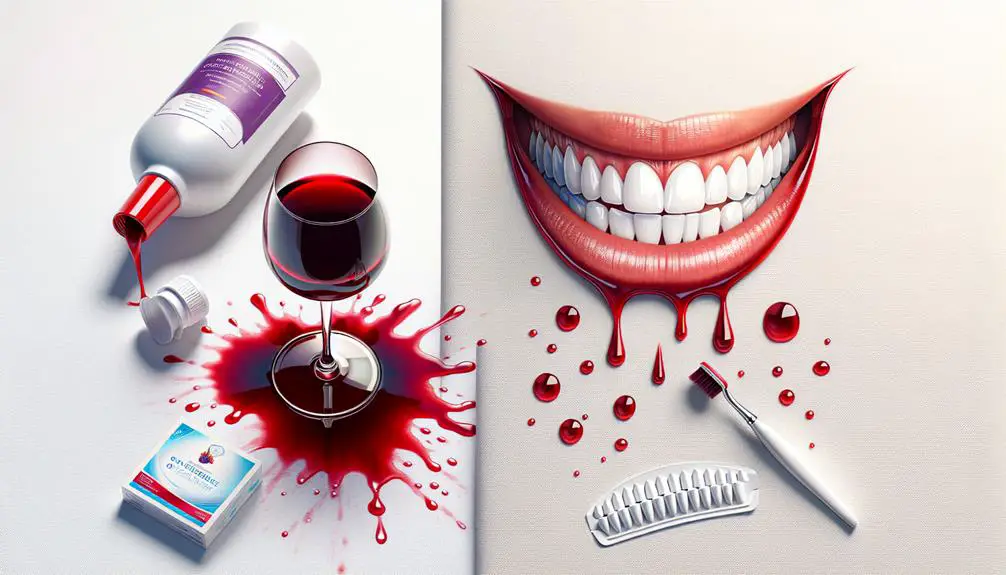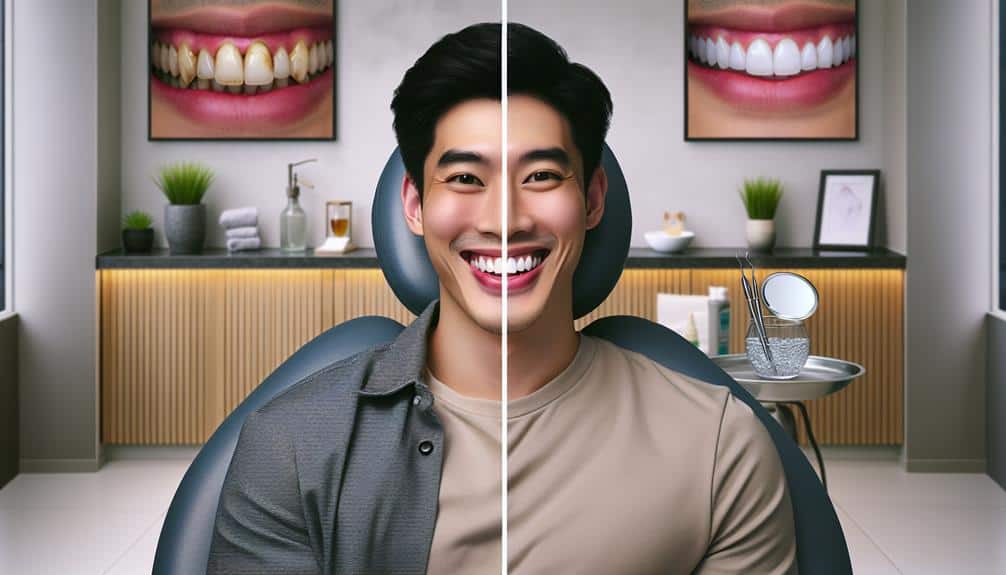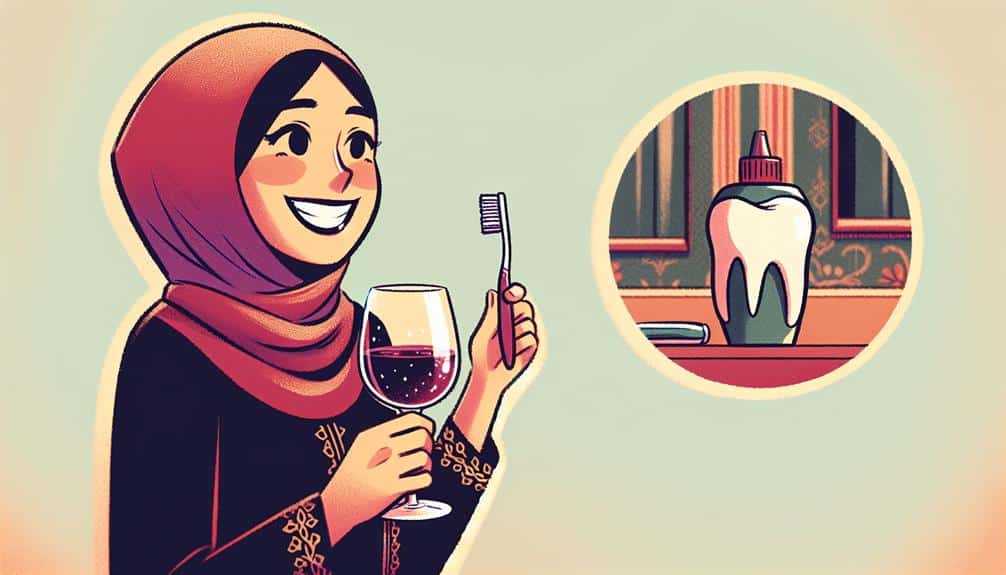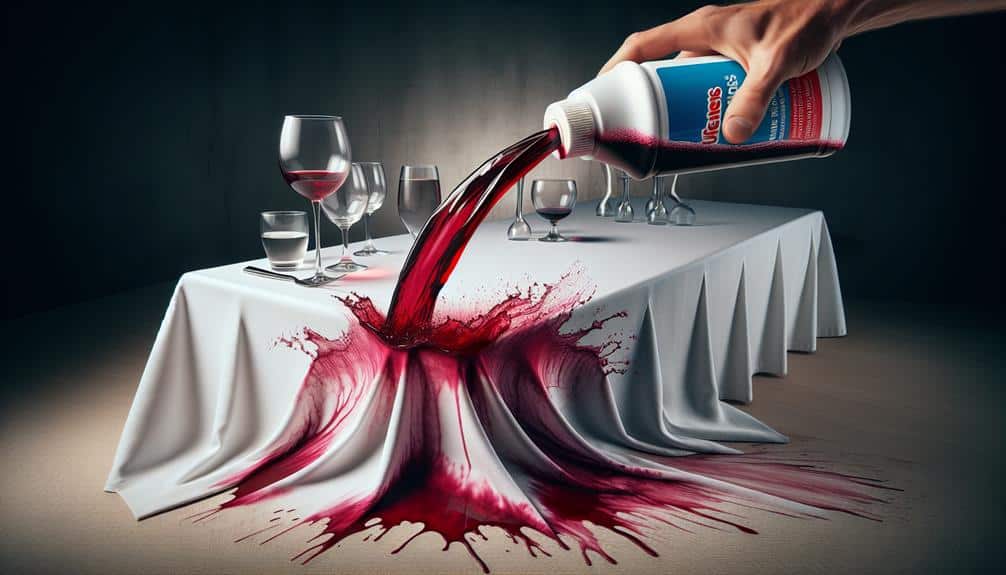To remove wine stains and whiten teeth, try natural solutions like baking soda and hydrogen peroxide. Baking soda's abrasiveness helps scrub away stains, while hydrogen peroxide acts as a mild bleaching agent. These methods are cost-effective and effective against stains. For a brighter smile, these remedies offer a dual benefit of stain removal and teeth whitening.
Key Points
- Baking soda effectively removes wine stains with its abrasive properties.
- Hydrogen peroxide can lighten stains as a gentle bleaching agent.
- Coconut oil pulling naturally whitens teeth by reducing bacteria.
- Professional whitening options like in-office treatments or at-home kits offer immediate results.
- Prevent stains by maintaining oral hygiene, drinking water, and using a straw while consuming wine.
Understanding Wine Stains on Teeth
To understand how wine stains teeth, it's important to grasp the composition and properties of wine that contribute to discoloration. Wine, whether red or white, contains chromogens, tannins, and acids that can lead to teeth discoloration. Chromogens are intensely pigmented molecules that adhere to the enamel of your teeth, causing staining. Tannins, which are naturally occurring compounds in wine, have astringent properties that help the chromogens bind to your teeth more easily. Additionally, the acidity of wine can weaken the enamel, making it more susceptible to picking up stains.
When it comes to wine stain prevention, there are several strategies you can employ. Drinking water alongside wine can help wash away some of the staining compounds and reduce their impact on your teeth. Another effective method is to brush your teeth or rinse your mouth after consuming wine to prevent the pigments from settling on the enamel. Moreover, using a straw when drinking wine can help minimize its contact with your teeth, reducing the risk of discoloration.
Best Practices for Wine Stain Removal
One effective method for removing wine stains from teeth is by utilizing natural ingredients known for their stain-fighting properties. Quick solutions are readily available, with common household items offering DIY tricks for stain removal. Baking soda, for example, is a popular choice due to its abrasive nature, which helps scrub away surface stains.
Create a paste by mixing a small amount of baking soda with water and gently brush it onto your teeth. Rinse thoroughly after a minute or two. Another effective DIY trick involves using hydrogen peroxide, a mild bleaching agent that can help lighten stains. Mix a small amount of hydrogen peroxide with water, swish it around in your mouth for about a minute, and then spit it out. Remember not to swallow the solution.
These quick solutions can be a convenient way to tackle wine stains before they set in, providing a cost-effective and easy-to-implement approach to maintaining a bright smile.
Natural Remedies for Whiter Teeth
For a natural approach to achieving whiter teeth, consider incorporating home remedies known for their teeth-whitening properties. DIY solutions can be effective in brightening your smile without the use of harsh chemicals.
One popular remedy is baking soda, which has mild abrasive properties that can help remove surface stains on teeth. You can create a paste by mixing a small amount of baking soda with water and brushing your teeth gently. Another common home remedy is coconut oil pulling, where swishing coconut oil in your mouth for about 15 minutes daily is believed to reduce bacteria and promote whiter teeth.
Strawberries are also known for their teeth-whitening benefits due to their malic acid content, which can naturally remove stains. Mash up a ripe strawberry and mix it with baking soda to create a natural whitening paste. Additionally, hydrogen peroxide, when diluted with water, can act as a natural whitening agent. However, it's important to use this method sparingly to avoid damaging your enamel.
Professional Whitening Options
Consider exploring professional whitening options to achieve a brighter and more radiant smile. In-office treatments and at-home kits are two popular choices for those looking to whiten their teeth professionally.
In-office treatments typically involve a one-time visit to the dentist, where they use stronger whitening agents that can provide immediate results. On the other hand, at-home kits offer the convenience of whitening your teeth in the comfort of your own home. These kits often come with custom trays that mold to your teeth for a more personalized whitening experience.
Laser whitening is another professional option that has gained popularity in recent years. This procedure involves the use of a laser to accelerate the whitening process, providing quick and effective results. Custom trays, on the other hand, are trays specifically designed to fit your teeth, ensuring that the whitening agent is evenly distributed for consistent results.
When considering professional whitening options, it's essential to consult with your dentist to determine the best choice for your individual needs and preferences.
Preventing Wine Stains in the Future
To prevent wine stains in the future, explore strategies to protect your teeth from discoloration caused by red wine consumption. Preventing discoloration involves incorporating important oral hygiene habits into your daily routine.
Brush your teeth at least twice a day with a fluoride toothpaste to remove plaque and stains that can develop from drinking red wine. Flossing daily is also essential to remove food particles and plaque between your teeth, preventing them from becoming stained. Additionally, consider using a whitening mouthwash to help maintain the brightness of your teeth and reduce the impact of wine stains.
Another effective way to prevent wine stains is to drink water alongside your red wine. Swishing water around your mouth after consuming red wine can help wash away some of the pigments that cause staining. Using a straw while drinking wine can also minimize its contact with your teeth, reducing the risk of discoloration. By incorporating these preventive measures into your routine, you can enjoy a glass of red wine without worrying about the impact on your teeth.
Frequently Asked Questions
Can Using Whitening Toothpaste Prevent Wine Stains on Teeth?
Using whitening toothpaste can enhance your smile and potentially reduce wine stains on teeth. While it may not completely prevent stains, the abrasive nature of whitening toothpaste can assist in minimizing discoloration caused by wine.
Are There Any Specific Types of Wine That Are More Likely to Cause Stains on Teeth?
When it comes to teeth staining, red wine is notorious for its ability to leave unsightly marks. The pigments in red wine, such as anthocyanins, can easily adhere to your enamel, causing discoloration.
How Long Do Wine Stains Typically Take to Develop on Teeth After Consumption?
After consuming wine, stains on teeth typically start forming within minutes to hours. To prevent this, consider stain removal and teeth whitening options. Immediate actions like rinsing with water can help minimize stains until you can properly clean your teeth.
Can Using a Straw While Drinking Wine Help Prevent Stains on Teeth?
To prevent wine stains on teeth, using a straw can help by minimizing direct contact with your enamel. Additionally, choosing a whitening toothpaste with gentle abrasives like baking soda or silica can further aid in maintaining a bright smile.
Is It Safe to Use DIY Teeth Whitening Remedies Frequently for Long-Term Results?
Using DIY teeth whitening remedies frequently may result in teeth sensitivity. To guarantee long-term results, take necessary DIY precautions like limiting use and consulting with a dentist. Overuse can harm enamel, so proceed with caution.



